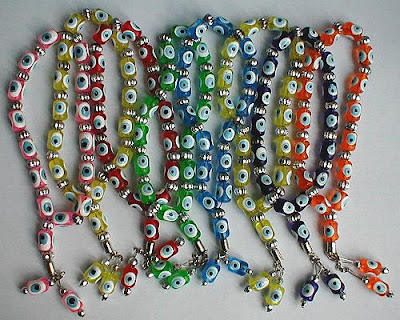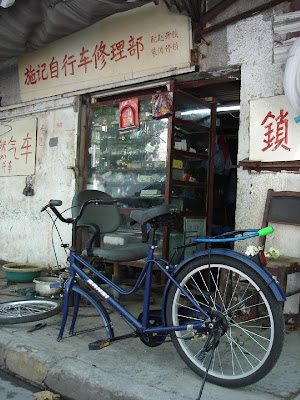"America is a place where Jewish merchants sell Zen love beads to Agnostics for Christmas." |
~John Burton Brimer |

One thing I've really become aware of in exploring these textile studies is how little we as a society value craft. Beading is no exception though beads have been with us from the very beginning and are still a big part of our spiritual and decorative lives today.
Beading started when the first caveman picked up a sharp tool and put a hole in some natural found object and strung a piece of fibre through it. Think of Ceremonial tribesman of any culture- usually they have beaded necklaces of teeth, bones, seed pods, or shells. These beaded head pieces, necklaces, belts, bracelets etc. Were worn as decoration, as religious symbols or as protection. Animal bones were worn to either protect the wearer from that beast as a kind of amulet, or to invoke the spirit of that beast in battle or in Religious ceremonies.
Egyptian beaded necklace. Almost worth a curse just to touch it! Faience beadwork.
The Egyptians (of course!) were the first to create glass beads, and even discovered how to add pigments to the glass. They mixed up their beads with semi precious stones, gold and silver, and these beads were traded like currency and exported around the ancient world. They also made clay beads that were mixed with silica sand, lime and soda, wrapped around a piece of straw and fired in a kiln. These kinds of long beads are called faience beads. Some of these beads have been found in masks and beaded nets laid over mummies bodies for spiritual protection.
The Vikings also had a strong history of making beads and were quite prolific in making beads, bracelets, amulets and necklaces. The Romans traded beads like currency.
In Europe, there was a strong glass bead making factory in the centre of Venice, which thrived until the Ventians stated to worry that the kiln could blow up and destroy the city. So they moved the factory to a small island called Murano, and this as the birth of Murano glass. Murano held the monopoly on glass beads for 600 years before the demand became too high. In the past few years there has been a resurgence of interest in Murano glass beads.
In the early 20th Century, Victoria and Edwardian aristocrats began beading their gowns and all of their accessories, as illustrated by Queen Mary who had a penchant for pearls.
Okay, I could have found a 20's flapper dress, but I wish I was skinny enough to pull this dress off myself!
(But not as skinny as Kate Moss. Promise.)
In the 1920s, the flapper girls also beaded everything from head dresses to fringed on dresses and a long string of pearls ties in a knot was the ultimate accessory. At this time, inexpensive plastic beads were created and the bead world exploded!
We couldn't talk about beads without mentioning the hippies, Thank you, Janice.
When I was a wee child, Macrome beading was a national sport!
North American Natives also have a strong history of beading and this traditional beadwork is still fashionable in parts of the USA today. Young girls were recruited into the quilling society, and trained on the traditional methods of bead work. However, the training was not so focused on the finished product but rather on the sacredness almost meditative, spiritual journey of the beading process itself.
African tribes also have a strong history of beading, and though it's too much information to post here, I found this page on Zulu beading to be super interesting; the designs are designed to give information to the opposite sex: the colours all have meaning, The geometric designs have meaning, and the pieces people wear transmit the information the public needs to know about that particular person. If you are interested, you can read all about it (Click here!)
Even Baby Jesus loved his beads.
Two for one deal: Ottoman Tespih prayer beads, and Turkish evil eyes to ward off jealousy and general badness.
And through history beads have played an important part of religious and spiritual ceremonies as we still see today: The catholics have rosaries, the Muslims (in particular the Turks) have Ottoman Tespih beads, the buddhists and the yoga practictioners of the world have mala beads- they are even found on the cover of Elizabeth Gilbert's Eat Pray Love book if you don't believe me. And beads worn on the body are still used for protection today, just look at the Evil Eye most often found in Turkey but found through out the Middle East and Greece as well. It has the power to ward off the evil eye and no mother in her right mind would let her children out the door without one somewhere on their body.
Mala beads in the word "pray." I've noticed lots of yoga practitioners with mala beads wrapped around their wrists in class. Some Traditional Tibetan ones are made with skulls.
So enough history and one to my beading project. I asked my Dad to make me a beading loom around Christmas, and he happily obliged. We looked at a few pictures on the internet and came up with a very basic loom of a u shaped construction made out of scrap wood with some nails fired into each end. I wasn't sure it would work, but I gave it a try.
I first looked on the net for beaded bracelets to give me some inspiration. I found a beautiful design, and using graph paper, I made my own design, the width of twenty six tiny beads side by side. It was going to be stunning! Designer! But then I went to string my loom with beading wire. It was kinky and unruly. Worse yet, when I went to put my first grouping of beads across, some of the wire kinked and I would have to abandon the strand. This is where I learned that Nylon chord is much better for beading bracelets like this. So I ripped out all of the wire and replaced it with extra strong sewing thread. I didn't have any nylon chord and was itching to get the project started.
I also realised that 26 tiny beads across was a greater width than my beading needle. This would be a nightmare. I also realised that I'd be counting coloured beads like a mathematician and not really enjoying the process. And this would take me forever. I've also recently been told by my physiotherapist that I'm spending too much time hunched over projects and my shoulders are starting to complain bitterly. So I decided that like the Indian Quilling Society, this project would be about the process and not about the finished product.
So I cut it down to ten. I also spent a lot of time separating all these little beads into different beading containers. I listened to music and beaded, and though I wasn't really sure what I was making, or whether or not I would like the finished product, I really did find the process meditative and relaxing. I was going to make another bracelet, this time with a more daring design, but whenI took this picture I knocked over all of the little beading jars, thus ending my beading career for the immediate future!
Dad's impromptu bead loom.
Considering neither of us knew what we were doing, it worked pretty well!
So here is how you do it. You put your beads on a string, one bead between each of your warp threads.
Next, you slide the string of beads under the warp threads, and push them up as far as they will comfortable go.
Next, you slide your needle through the beads but this time trying to keep your thread above the warp threads. Essentially you've got a string running through the bottom and another on the top inside the beads. Don't worry if you miss one or two, because you sew back through them all at the end anyways to give it added strength. Repeat until finished!
When the beads are ready to come off, you tie them just like you would a weaving, by tying two warp threads together.
Almost finished beading!
If I were a Zulu girl, I wonder what my beading would tell the boys?
Probably that I like to read, considering it's destined to become a bookmark.
When I was done, I hand-sewed the whole thing to the back of a velvet ribbon, added a tassel to each end, and now I have a fancy beaded bookmark.
xxMelanie




















































